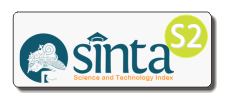PENGEMBANGAN MODEL PEMBELAJARAN IPA BERBASIS 4N (NENG, NING, NUNG, NANG) UNTUK MENCIPTAKAN PROSES BELAJAR FUNGSIONAL PESERTA DIDIK SMP
Djohar Djohar, Universitas Negeri Yogyakarta, Indonesia
Abstract
The aims of this study are (1) to develop 4N concept from Ki Hajar Dewantara into 4N model of learning for science, (2) to investigate the quality of developed products, (3) to investigate the effect of 4N learning model for scinece learning to Tri Nga competencies, and (4) to investigate the implementation of the model.The study used 9 steps of research and development (R&D) model of Borg & Gall without taking the dissemination process.The results of the study are as follows. (1) The 4N concept was developed to become 4N model for science learning. (2) The Products are appropriate to use for teaching and learning process. (3) The 4N learning model can achieve a functional science learning: (a) the model can increase Tri Nga competencies. (b) Science learning using the 4N model achieves the KKM target, and (c) the 4N model gets good response from the students. (4) The 4N model is in well done category.
Key words: learning model, 4N (neng-ning-nung-nang) concept, functional learning.
Full Text:
PDFReferences
Anwar, K. & Harmi, H. (2011). Perencanaan sistem pembelajaran kurikulum tingkat satuan pendidikan (KTSP). Bandung: Alfabeta.
Aunurahman. (2010), Belajar dan pembelajaran. Alfabeta, Bandung.
Borg, W.R. & Gall, M.D. (1983). Educational research: an introduction.4 th Edition. New York: Longman Inc.
Bundu, P. (2006). Penilaian keterampilan proses dan sikap ilmiah dalam pembelajaran sains Sekolah Dasar. Jakarta: Depdiknas.
DePorter, B.; Reardon, M.; & Singer-Nourie, S. (2001). Quantum teaching: mempraktikkan quantum learning di ruang-ruang kelas. (terjemahan Ary Nilan-Dary).
Boston: Allyn and Bacon. Dewantara, K.H. (1977). Pendidikan. Yogyakarta: Majelis Luhur Persatuan Taman Peserta didik.
Widoyoko, S.E.P. (2012). Teknik penyusunan instrumen penelitian. Yogyakarta: Pustaka Pelajar.
Ghozali, I. (2011). Aplikasi Analisis Multivariate dengan program IMB SPSS 19. Semarang: Badan Penerbit Universitas Diponegoro.
Hamalik, O. (2005). Proses belajar mengajar. Jakarta: PT Bumi Aksara
Joyce, B,. & Weil, M. (1996). Models of Teaching. USA: A Simon & Schuster Company.
Riyanto, Y. (2010). Paradigma baru pembelajaran sebagai referensi bagi pendidik dalam implementasi pembelajaran yang efektif dan berkualitas. Jakarta: Kencana.
Setiawan, E. (2010). Kamus Besar Bahasa Indonesia Versi 1.1. [versi elektronik]. Diambil pada tanggal 30 September 2013.
Sharma, A. (2012). What are the functions of education towards individual, society, and country?. Artikel. Diambil pada tanggal 21 Maret 2012, dari http:/www.preservearticles.com2011022 44178/what-are-the-functions-ofeducation-towards-individual,-societyand-country.html
Sugiyono. (2010). Metode penelitian pendidikan. Bandung: Penerbit Alfabeta.
Suparno, Pl. (2007). Metodologi pembelajaran fisika; konstruktivistik dan menyenangkan. Yogyakarta: Universitas Sanata Dharma.
Tim Pengembang Ilmu Pendidikan FIP-UPI. (2007). Ilmu dan aplikasi pendidikan. Jakarta: Imtima.
Tim Puslitjaknov. (2008) .Metode Penelitian Pengembangan. Depdiknas.
Thut I.N, Adams, D. (2005). Pola-pola Pendidikan dalam Masyarakat Kontem-porer. Yogyakarta: Pustaka Pelajar.
DOI: https://doi.org/10.21831/jipi.v1i1.4528
Refbacks
- There are currently no refbacks.
Copyright (c)
Jurnal Inovasi Pendidikan IPA indexed by:

Jurnal Inovasi Pendidikan IPA by http://journal.uny.ac.id/index.php/jipi/index is licensed under a Creative Commons Attribution-ShareAlike 4.0 International License.
All rights reserved. p-ISSN: 2406-9205 | e-ISSN: 2477-4820
View My Stats













